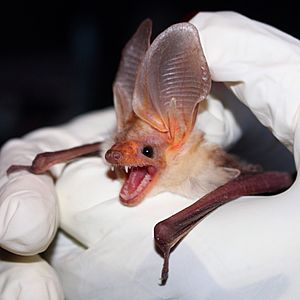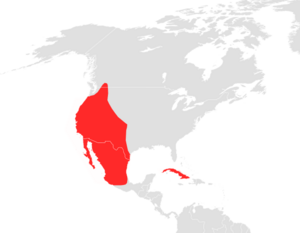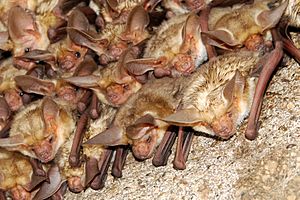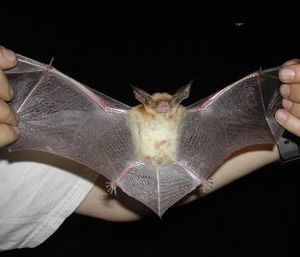Pallid bat facts for kids
Quick facts for kids Pallid bat |
|
|---|---|
 |
|
| Conservation status | |
| Scientific classification | |
| Genus: |
Antrozous
|
| Species: |
pallidus
|
 |
|
| Pallid bat range | |
The pallid bat (Antrozous pallidus) is a special type of bat. You can find these bats from western Canada all the way down to central Mexico. It's the only species in its group, called a genus. It's also related to another bat called Van Gelder's bat. Scientists sometimes even put Van Gelder's bat in the same group as the pallid bat.
Even though it used to be in its own special family, the pallid bat is now considered part of a larger bat family called Vespertilioninae.
Contents
About the Pallid Bat
Pallid bats are medium-sized bats. Their head and body are about 2.75 inches (6.2-7.9 cm) long. Their forearms, which are part of their wings, are about 2.1 inches (4.5–6 cm) long. Their tails are around 1.75 inches (3.9-4.9 cm) long. When their wings are spread out, they can reach 15-16 inches (38–40 cm) wide!
These bats usually weigh between 14 and 25 grams. They have very long ears that point forward, measuring over 2.5 cm. Their fur is light brown on their back and much lighter on their belly. Pallid bats also have a unique, blunt snout that looks a bit like a pig's nose.
Where Pallid Bats Live and What They Eat

Pallid bats usually live in dry or partly dry places. You can often find them in mountains or rocky areas, especially near water. They also like open grasslands with not too many plants.
During the day, these bats sleep in safe spots. They might hide in cracks in rocks, under loose tree bark, or even in spaces under roof tiles. At night, they often use a different resting spot. This "night roost" is usually closer to where they hunt for food. Night roosts are often less hidden, like an open porch. In winter, pallid bats might go into a light sleep called torpor. They do this in buildings, caves, or rock cracks to save energy.
Pallid bats are mostly insectivores, meaning they eat insects. They love to eat crickets and other bugs. They can even eat up to half their own body weight in insects every single night! These bats are "gleaners." This means they pick up their prey from the ground. Then, they take the food back to their night roost to eat it. When they hunt, pallid bats fly very low, usually just 1–2 meters above the ground.
One amazing thing about pallid bats is that they eat Arizona bark scorpions. These scorpions are the most venomous in North America, and their stings can be very dangerous for humans. Scientists found that pallid bats have special changes in their bodies. These changes make them resistant to scorpion venom.
Even though they mostly eat insects, pallid bats can also change their diet. In spring, they drink nectar from Mexican cacti, like the cardón cactus. In summer, they might even eat the cactus fruit. They are also very good at helping these cacti grow by spreading their pollen.
Pallid bats are special because they can control their body temperature. This means they can be like "cold-blooded" animals or "warm-blooded" animals depending on the time of year. They can match their body temperature to the environment when they rest or during winter hibernation.
The size of a pallid bat can change a lot depending on where it lives. Bats in deserts, where there's less food, tend to be smaller. Bats living in places with more food, like coastal areas, are usually bigger. Bigger pallid bats also have stronger skulls. This helps them eat larger, tougher prey more easily.
Pallid Bat Life Cycle and Behavior
Pallid bats mate during the winter, from October to February. This is when they are in their light sleep (hibernation). Male bats store their sperm during spring and summer. This happens because of changes in daylight hours. Females store the sperm until spring. Then, when they wake up from hibernation, they become ready to have babies.
Female bats usually give birth to one or two babies, called pups, in early June. Newborn pups weigh about 3 to 3.5 grams. In about four or five weeks, these young bats can make short flights. They stop drinking their mother's milk after 40 to 45 days. Pups don't reach their full adult size until they are about eight weeks old. They become old enough to have their own babies when they are around two years old.
Like most bats, pallid bats use echolocation to find their way. They send out sounds and listen for the echoes to create a picture of their surroundings. They use this to fly and find food. However, pallid bats are unique because they often don't use echolocation when hunting. Instead, they use their large ears to listen for insects moving on the ground. They mostly rely on the sounds their prey makes to catch them.
Unfortunately, noise pollution from things like traffic can make it harder for pallid bats to hunt. This noise can reduce how well they find food by up to three times.
Scientists have found evidence of pallid bats from a very long time ago. Their fossils have been found in places like the western United States and Cuba.
See also
 In Spanish: Murciélago pálido para niños
In Spanish: Murciélago pálido para niños



